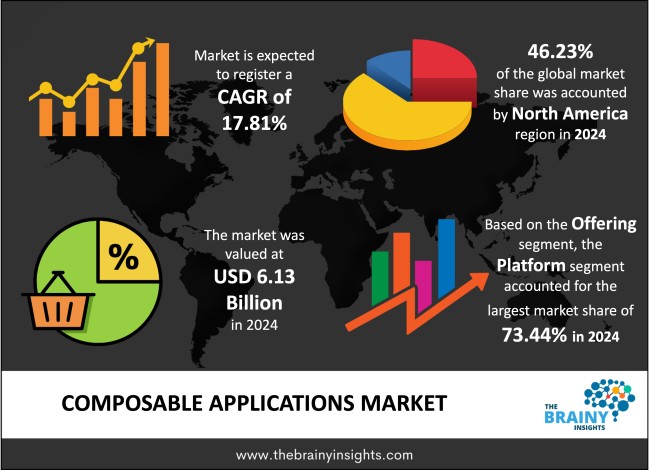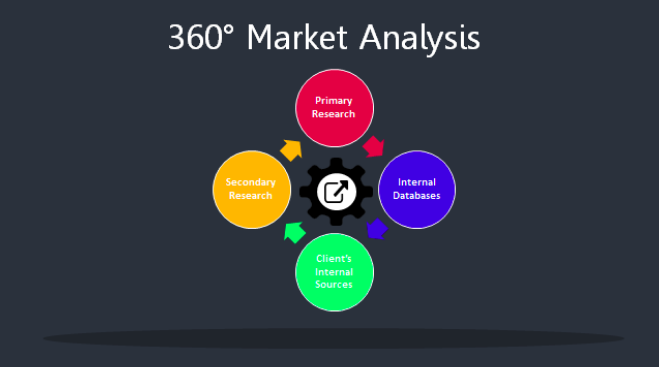- +1-315-215-1633
- sales@thebrainyinsights.com

The global Composable Applications market was valued at USD 6.13 Billion in 2024 and grew at a CAGR of 17.81% from 2025 to 2034. The market is expected to reach USD 31.55 Billion by 2034. The market is driven by the reduction in costs associated with maintaining a large IT team, as there is no need to rewrite existing code. It only requires to be reconfigured. According to one study, approximately 30% of new applications were estimated to be composable and would have built-in Package Business Capabilities (PBCs) by 2023. Composable applications are a set of reusable and independent programs which exist together for creating new applications, and their functionality can't be achieved independently. It means the composable applications are a collection of off-the-shelf products connected by APIs to create a new application. These APIs enable the programs to interact with each other. It appears that several organizations are embracing digital transformation to enhance business operations, and therefore, it is crucial to stay ahead in the application development required. Hence, the demand for composable applications is growing.
Composable applications are essentially software systems designed to be modular and interoperable, allowing them to be easily combined or composed with others to create new functionality. This method of software design offers flexibility and reuse. Thus, it allows developers to develop applications by combining and configuring smaller, independent components, eliminating the need to build everything from scratch. Composable has become the leading technological trend for digital acceleration in the hyper-connected economy, as there is a significant dependency on software and a shortage of tech talent to meet the required needs. Composable applications offer several advantages, including faster time to market, improved scalability, and cost efficiency. Organizations can easily deploy new features and integrate third-party services. Thus, it facilitates easy adaptation to industry shifts without requiring the entire system to be rewritten. Moreover, it enhances the customer experience by offering personalized and dynamic digital interactions. It helps in making the business competitive in this fast-evolving scenario.
Composable applications offer numerous benefits, including ease of use, automation, agility, and nimbleness. Currently, composable applications provide a simpler environment for businesses to utilise a single model across the organisation. It also helps prevent the wastage of investment by providing staff training, along with offering a better learning environment. Composable applications also provide constant and continuous delivery of IT applications and services. Many new applications are being developed following improvements in conventional ones. These new applications need responsiveness and stability, which can be done using composable applications. The composable application utilises template-driven approaches to minimise provisioning time delays, ensuring resources are available when needed. Hence, the business can gain a strategic advantage but still suffer from scalability problems. A composable app helps in updating existing app components, eliminating the need to work on complete apps. This approach enables developers to speed up development by avoiding the need to start from scratch. Moreover, developers can launch features and updates more quickly by developing and testing small, independent components rather than large, outdated applications. Composability offers a plug-and-play architecture, which helps organizations pool resources by swapping, dismantling, and reassembling components more quickly to meet the evolving pace of business transformation.

Get an overview of this study by requesting a free sample
Surge in digitalization– There are several modern software platforms which use composable architecture. Like many e-commerce platforms, the integration of business with payment gateways, customer management tools, and analytics is achieved in separate modules. Additionally, some content management systems (CMS) enable businesses to select and integrate only the functionalities required, such as headless CMS, AI-powered search, or personalised engines. Composable applications offer numerous benefits, including faster time to market, improved scalability, and cost efficiency. Composable applications enable businesses to swiftly deploy new features, integrate third-party services, and make quick adjustments to market shifts without the need to rewrite code from scratch. Additionally, it enhances the customer experience by enabling personalised and dynamic digital interactions. Thus making the business in demand as it adapts to the needed change. All these factors eventually propel the growth of the Composable Applications market.
Integration Complexities – Several factors affect the market's growth, including integration complexities and a shortage of skilled professionals. The integration of composable components with IT infrastructure can be a complex process, which may lead to increased time and resource expenses. Additionally, there is a shortage of professionals with the proper expertise in composable applications and architecture. Additionally, concerns such as security risks and high initial costs are also hindering market growth. Moreover, there is a continuous requirement for adaptation. All these factors are acting as restraints for the market.
Evolving business scenarios – It has been observed that composable applications and digital transformation are inextricably linked, and they rely on each other to meet the evolving needs of the business. Digital transformation is a common approach in business practices, and composable applications can help create an interdependent system. The advantage of the composable application is huge due to the evolving nature of the independent self-governing system. Thus, even if one system stops working, it will not affect the complete operation, and it can certainly be adjusted and fixed. Additionally, another advantage of composable applications related to digital transformation is that they enable developers to be more productive. Several applications can be integrated quickly into the technology stacks without the need for any data silos. All these factors increase the demand for composable applications during the forecasting period.
The regions analysed for the market include North America, Europe, South America, Asia Pacific, the Middle East, and Africa. North America emerged as the most significant global Composable Applications market, with a 46.23% market revenue share in 2024.
The North American region leads the Composable Applications market, primarily due to the growing adoption rates of composable applications, which are attributed to the region's robust and sustainable economies. Additionally, there is increased investment in R&D to focus on innovative technologies. There is a surge in the adoption of advanced technologies, such as digital transformation. These factors will ultimately lead to a high demand for Composable Applications in the region.
North America Region Composable Applications Market Share in 2024 – 46.23%
www.thebrainyinsights.com
Check the geographical analysis of this market by requesting a free sample
The offering segment is divided into Platform and Service. Platform segment dominated the market, with a market share of around 73.44% in 2024. This significant share is attributed to the surge in the adoption of cloud applications, which is fuelling the need for application integration solutions, microservices and APIs. It eventually led to an increase in the use of composable applications. All businesses currently want to utilise such platforms to streamline their development process, automate tasks, and assist their developers by allowing them to use drag-and-drop features.
The end user segment is divided into BFSI, healthcare, energy and utilities, manufacturing, retail and others. The BFSI segment dominated the market, with a market share of around 30.43% in 2024. This significant share is due to the growing use of composable applications for financial institutions' apps, such as bank apps, whose operations largely depend on reusability, modularity, and adaptability. In the current scenario, financial institutions, such as banks, have recognised that application development is the cornerstone of their digital transformation objectives.
| Attribute | Description |
|---|---|
| Market Size | Revenue (USD Billion) |
| Market size value in 2024 | USD 6.13 Billion |
| Market size value in 2034 | USD 31.55 Billion |
| CAGR (2025 to 2034) | 17.81% |
| Historical data | 2021-2023 |
| Base Year | 2024 |
| Forecast | 2025-2034 |
| Region | The regions analyzed for the market are Asia Pacific, Europe, South America, North America, and Middle East and Africa. Furthermore, the regions are further analyzed at the country level. |
| Segments | Offering and End User |
As per The Brainy Insights, the size of the global Composable Applications market was valued at USD 6.13 Billion in 2024 to USD 31.55 Billion by 2034.
Global Composable Applications market is growing at a CAGR of 17.81% during the forecast period 2025-2034.
The market's growth will be influenced by surge in digitalization.
Integration complexities could hamper the market growth.
This study forecasts revenue at global, regional, and country levels from 2021 to 2034. The Brainy Insights has segmented the global Composable Applications market based on below mentioned segments:
Global Composable Applications Market by Offering:
Global Composable Applications Market by End User:
Global Composable Applications Market by Region:
Research has its special purpose to undertake marketing efficiently. In this competitive scenario, businesses need information across all industry verticals; the information about customer wants, market demand, competition, industry trends, distribution channels etc. This information needs to be updated regularly because businesses operate in a dynamic environment. Our organization, The Brainy Insights incorporates scientific and systematic research procedures in order to get proper market insights and industry analysis for overall business success. The analysis consists of studying the market from a miniscule level wherein we implement statistical tools which helps us in examining the data with accuracy and precision.
Our research reports feature both; quantitative and qualitative aspects for any market. Qualitative information for any market research process are fundamental because they reveal the customer needs and wants, usage and consumption for any product/service related to a specific industry. This in turn aids the marketers/investors in knowing certain perceptions of the customers. Qualitative research can enlighten about the different product concepts and designs along with unique service offering that in turn, helps define marketing problems and generate opportunities. On the other hand, quantitative research engages with the data collection process through interviews, e-mail interactions, surveys and pilot studies. Quantitative aspects for the market research are useful to validate the hypotheses generated during qualitative research method, explore empirical patterns in the data with the help of statistical tools, and finally make the market estimations.
The Brainy Insights offers comprehensive research and analysis, based on a wide assortment of factual insights gained through interviews with CXOs and global experts and secondary data from reliable sources. Our analysts and industry specialist assume vital roles in building up statistical tools and analysis models, which are used to analyse the data and arrive at accurate insights with exceedingly informative research discoveries. The data provided by our organization have proven precious to a diverse range of companies, facilitating them to address issues such as determining which products/services are the most appealing, whether or not customers use the product in the manner anticipated, the purchasing intentions of the market and many others.
Our research methodology encompasses an idyllic combination of primary and secondary initiatives. Key phases involved in this process are listed below:

The phase involves the gathering and collecting of market data and its related information with the help of different sources & research procedures.

The data procurement stage involves in data gathering and collecting through various data sources.
This stage involves in extensive research. These data sources includes:
Purchased Database: Purchased databases play a crucial role in estimating the market sizes irrespective of the domain. Our purchased database includes:
Primary Research: The Brainy Insights interacts with leading companies and experts of the concerned domain to develop the analyst team’s market understanding and expertise. It improves and substantiates every single data presented in the market reports. Primary research mainly involves in telephonic interviews, E-mail interactions and face-to-face interviews with the raw material providers, manufacturers/producers, distributors, & independent consultants. The interviews that we conduct provides valuable data on market size and industry growth trends prevailing in the market. Our organization also conducts surveys with the various industry experts in order to gain overall insights of the industry/market. For instance, in healthcare industry we conduct surveys with the pharmacists, doctors, surgeons and nurses in order to gain insights and key information of a medical product/device/equipment which the customers are going to usage. Surveys are conducted in the form of questionnaire designed by our own analyst team. Surveys plays an important role in primary research because surveys helps us to identify the key target audiences of the market. Additionally, surveys helps to identify the key target audience engaged with the market. Our survey team conducts the survey by targeting the key audience, thus gaining insights from them. Based on the perspectives of the customers, this information is utilized to formulate market strategies. Moreover, market surveys helps us to understand the current competitive situation of the industry. To be precise, our survey process typically involve with the 360 analysis of the market. This analytical process begins by identifying the prospective customers for a product or service related to the market/industry to obtain data on how a product/service could fit into customers’ lives.

Secondary Research: The secondary data sources includes information published by the on-profit organizations such as World bank, WHO, company fillings, investor presentations, annual reports, national government documents, statistical databases, blogs, articles, white papers and others. From the annual report, we analyse a company’s revenue to understand the key segment and market share of that organization in a particular region. We analyse the company websites and adopt the product mapping technique which is important for deriving the segment revenue. In the product mapping method, we select and categorize the products offered by the companies catering to domain specific market, deduce the product revenue for each of the companies so as to get overall estimation of the market size. We also source data and analyses trends based on information received from supply side and demand side intermediaries in the value chain. The supply side denotes the data gathered from supplier, distributor, wholesaler and the demand side illustrates the data gathered from the end customers for respective market domain.

The supply side for a domain specific market is analysed by:
The demand side for the market is estimated through:
In-house Library: Apart from these third-party sources, we have our in-house library of qualitative and quantitative information. Our in-house database includes market data for various industry and domains. These data are updated on regular basis as per the changing market scenario. Our library includes, historic databases, internal audit reports and archives.
Sometimes there are instances where there is no metadata or raw data available for any domain specific market. For those cases, we use our expertise to forecast and estimate the market size in order to generate comprehensive data sets. Our analyst team adopt a robust research technique in order to produce the estimates:
Data Synthesis: This stage involves the analysis & mapping of all the information obtained from the previous step. It also involves in scrutinizing the data for any discrepancy observed while data gathering related to the market. The data is collected with consideration to the heterogeneity of sources. Robust scientific techniques are in place for synthesizing disparate data sets and provide the essential contextual information that can orient market strategies. The Brainy Insights has extensive experience in data synthesis where the data passes through various stages:


Market Deduction & Formulation: The final stage comprises of assigning data points at appropriate market spaces so as to deduce feasible conclusions. Analyst perspective & subject matter expert based holistic form of market sizing coupled with industry analysis also plays a crucial role in this stage.
This stage involves in finalization of the market size and numbers that we have collected from data integration step. With data interpolation, it is made sure that there is no gap in the market data. Successful trend analysis is done by our analysts using extrapolation techniques, which provide the best possible forecasts for the market.
Data Validation & Market Feedback: Validation is the most important step in the process. Validation & re-validation via an intricately designed process helps us finalize data-points to be used for final calculations.

The Brainy Insights interacts with leading companies and experts of the concerned domain to develop the analyst team’s market understanding and expertise. It improves and substantiates every single data presented in the market reports. The data validation interview and discussion panels are typically composed of the most experienced industry members. The participants include, however, are not limited to:
Moreover, we always validate our data and findings through primary respondents from all the major regions we are working on.
Free Customization
Fortune 500 Clients
Free Yearly Update On Purchase Of Multi/Corporate License
Companies Served Till Date